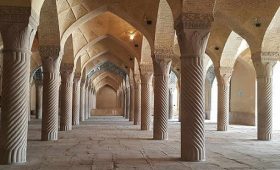The Jameh Mosque of Darab: A Historical Gem of Fars Province
The Jameh Mosque of Darab, situated in the historic city of Darab, is one of the most significant and ancient mosques in Iran, blending the deep historical roots of the Sassanid Empire with the architectural grandeur of Islamic Iran. Darab, once known as Darabgerd or Darabjerd, is one of the oldest cities in Fars Province, with a history stretching back thousands of years. The city’s development traces its origins to the pre-Islamic era, making the Jameh Mosque a landmark of both ancient and Islamic heritage. This article provides a detailed exploration of the Jameh Mosque of Darab, its architectural features, historical significance, and cultural importance.
The Historical Significance of Darab
Before diving into the Jameh Mosque, it is important to understand the historical context of Darab itself. Darab is located in the southeastern part of Fars Province, an area rich with ancient Persian history. Archaeological findings suggest that the region has been inhabited since the Achaemenid period (circa 550–330 BCE), and it continued to thrive during the Sassanid era (224–651 CE).
In ancient times, Darab was an important military and administrative center, and it was one of the key sites during the Sassanian period. The city of Darabgerd was fortified and strategically placed along the Silk Road, ensuring its prominence in the region. The remnants of Sassanian architecture, including fortresses, palaces, and fire temples, can still be found in the area, providing a fascinating glimpse into its past.
The Jameh Mosque itself stands as a symbol of the city’s transition from pre-Islamic to Islamic culture and architecture, making it not just a religious structure but also a piece of historical continuity. Its construction during the early Islamic period illustrates the adaptation of Iranian architectural traditions to new religious and cultural norms.
Architecture of the Jameh Mosque
The Jameh Mosque of Darab is a stunning example of early Islamic architecture in Iran, with traces of earlier Sassanian influence that continue to define its aesthetic and functional qualities. The mosque features a traditional hypostyle plan, characterized by a large open courtyard surrounded by porticoes and arcades. This layout is typical of early Islamic mosques, which were designed to accommodate large congregations for communal prayers and gatherings.
- The Dome: One of the most distinctive features of the Jameh Mosque of Darab is its dome, which rises majestically above the mosque’s central prayer hall. The dome’s construction is influenced by Sassanian architectural techniques, specifically the use of squinches, which are architectural features that allow for the transition from a square base to a circular dome. The dome’s interior is beautifully decorated with geometric patterns and intricate stucco work, typical of the Islamic period.
- The Minaret: The minaret of the Jameh Mosque is another architectural highlight, reflecting the early Islamic style of construction. The tall, slender structure is slightly tapered towards the top, and it is decorated with a series of horizontal bands of brickwork. The minaret was historically used to call the faithful to prayer, a practice that continues today in many mosques across Iran. Its height and ornate brickwork make it a prominent feature of the mosque, visible from a great distance.
- The Prayer Hall: The central prayer hall of the mosque is a large, open space that can accommodate hundreds of worshippers. The hall’s design is simple yet functional, with a mihrab (prayer niche) facing Mecca, and columns supporting the roof. The arcades surrounding the courtyard are also beautifully decorated, with intricate tilework and Islamic calligraphy adorning the walls. The mosque’s minimalist interior is designed to facilitate spiritual reflection and communal worship.
- Use of Sassanian Elements: The mosque incorporates several Sassanian architectural elements, particularly in the layout and the use of arches and domes. The Islamic period often adopted existing Sassanian elements, blending them with new Islamic styles and techniques. The Jameh Mosque of Darab is a perfect example of this, as it preserves certain elements of Sassanid design, such as the use of arches and the layout of the courtyard, while also introducing Islamic motifs and innovations.
The Religious and Cultural Importance of the Mosque
The Jameh Mosque of Darab has played an important role in the religious and cultural life of the region for over a millennium. Its location in Darab, an area that has long been a hub of Islamic and Zoroastrian activity, underscores the syncretic nature of Iran’s religious landscape.
- A Place of Worship: As a Jameh Mosque, the mosque served as the central place of worship for the local community, where the Friday prayers (Jumu’ah) and other important Islamic rituals were held. The mosque remains a significant spiritual center in the region, offering a space for reflection, prayer, and religious education.
- Cultural Heritage: The mosque is not only a religious site but also a symbol of the cultural heritage of Fars Province. It reflects the deep-rooted traditions of Persian architecture, combining the ancient styles of the Sassanid era with the evolving principles of Islamic architecture. The Jameh Mosque stands as a testament to the ability of Iranian culture to adapt and thrive across different historical and religious periods.
- A Bridge Between Eras: One of the most fascinating aspects of the Jameh Mosque of Darab is its role as a bridge between the ancient Zoroastrian and Islamic periods in Iran. The region around Darab was once a stronghold of Zoroastrianism, and many pre-Islamic structures still exist in the vicinity. The mosque’s construction represents a transition from the Sassanid religious practices to the Islamic practices that would dominate the region for centuries to come.
Restoration and Preservation Efforts
As one of the oldest mosques in Iran, the Jameh Mosque of Darab has undergone various restoration and preservation efforts to maintain its historical integrity. These efforts are critical in ensuring that the mosque continues to stand as a symbol of the region’s religious and architectural history.
Conservation projects have focused on preserving the mosque’s original brickwork, stucco decorations, and geometric designs, while ensuring that modern additions do not detract from the building’s historical authenticity. Efforts to safeguard the mosque’s minaret and dome have also been made, as these architectural features are vulnerable to weathering and erosion over time.
The Mosque as a Tourist Destination
In addition to its religious significance, the Jameh Mosque of Darab has become a major tourist destination in Fars Province. The mosque’s historical value, combined with its architectural beauty, attracts visitors from around the world. Those who visit the mosque not only come to worship but also to learn about Iran’s rich Islamic and pre-Islamic history.
Visitors to the mosque can explore its sacred spaces, admire its Islamic calligraphy, and experience the serenity of its courtyard. The mosque is often included in tours that explore the broader historical sites of Fars Province, including Persepolis, Naqsh-e Rostam, and Pasargadae, making it an essential stop for anyone interested in Iran’s ancient civilization.
The Jameh Mosque of Darab stands as a testament to the historical and architectural legacy of Iran, blending ancient Sassanid influences with Islamic architecture. Its unique design, historical significance, and cultural importance make it a must-see for anyone interested in exploring the rich heritage of Fars Province. As both a place of worship and a historical landmark, the mosque continues to inspire and educate visitors about the deep connections between Iran’s past and present.

